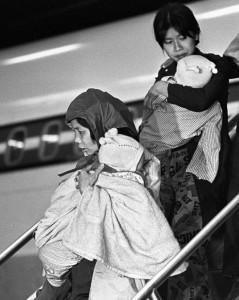6.5 Image Captions and Object Labels
Our guidelines for inclusive language also apply to image captions and object labels. However, because the word count for these types of text is very limited (generally 17-25 words), the CMHR applies additional standards to ensure the content is clear and straightforward and instantly accessible to as wide an audience as possible.
All caption and label text should pass the “So what?” test. This means that:
- Text should not consist of descriptions of the photographs and objects.
- Text should not repeat the same information presented in other texts in the gallery.
This type of text should interpret the image or object by offering interesting information that can’t be observed by visitors. Captions and labels can also anticipate—and answer—questions that the viewer might have about certain aspects of an image or object, as in this example:

Bad caption:
Montréal’s Dorval Airport, 1978. Vietnamese refugee women carry their young children off an airplane.
Good caption:
Vietnamese arriving in Montréal, 1978. Canada took in thousands of refugees who fled war-ravaged Vietnam.
Image Captions
Where possible, image caption text addresses an interesting detail in an image that encourages viewers to more closely observe the photograph. The text can also add information not visible in the photograph.
Information should be organized in the following sequence: description, location, date. They can be either a single sentence fragment followed by a period (in response to “In this picture, we see…”) or a sentence fragment followed by a full sentence.
- Examples:
- Members of the Reichstag, Germany’s Parliament, giving the Nazi salute, Berlin, around 1935. Note the eagle and swastika, symbolizing Nazi Germany, behind Adolf Hitler.
- Women factory workers, Winnipeg, around 1920. Hundreds of people laboured in the garment industry under sweatshop conditions that included long hours, low pay, and poor lighting and ventilation.
- Examples:
To ensure reader understanding, when two people appear in a photograph and their names are known, name the person on the left first and indicate their placement in the image inside brackets after their name (i.e., “left,” written in full).
When a group is depicted in a photograph and their names are known, list the names from left to right and indicate their placement in the image inside brackets (i.e., “left to right”).
Object Labels
The guidelines for image captions also apply to object labels; however, for this type of text the descriptor is formatted in bold and is not followed by a period.
Example of object label:

Ushiye Minamide’s registration card, 1941 These “enemy alien” cards stripped their bearers of rights and freedoms that other people in Canada enjoyed.